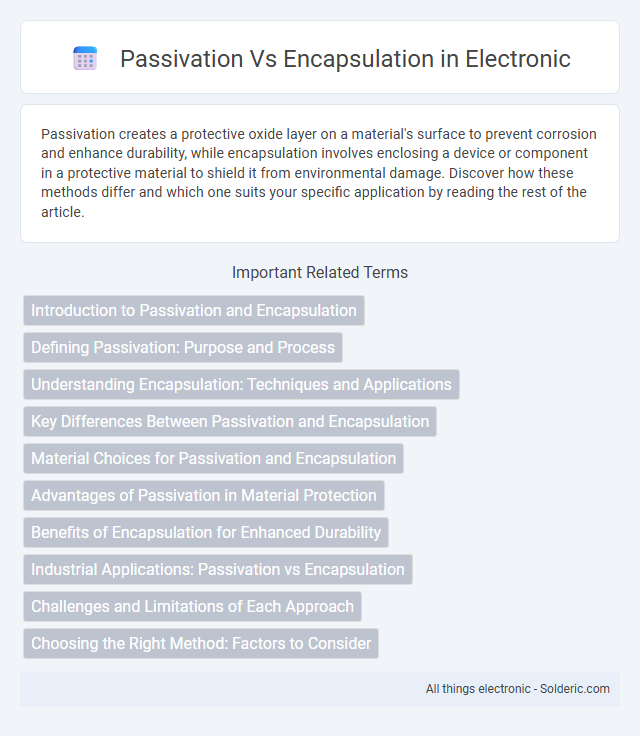Passivation creates a protective oxide layer on a material's surface to prevent corrosion and enhance durability, while encapsulation involves enclosing a device or component in a protective material to shield it from environmental damage. Discover how these methods differ and which one suits your specific application by reading the rest of the article.
Comparison Table
| Aspect | Passivation | Encapsulation |
|---|---|---|
| Definition | Process of creating a protective oxide layer to prevent corrosion. | Technique of coating or embedding material to shield from external elements. |
| Purpose | Enhance surface corrosion resistance and durability. | Protect against moisture, chemicals, or mechanical damage. |
| Materials Used | Typically metals like stainless steel, aluminum. | Polymer coatings, resins, epoxies, silicone. |
| Process Type | Chemical treatment forming thin oxide layer. | Physical or chemical application of protective coating. |
| Thickness | Nanometer to micrometer scale oxide film. | Micrometer to millimeter thick layers. |
| Common Applications | Electronics, metal fabrication, aerospace. | Electronics packaging, construction, automotive parts. |
| Effect on Surface | Minimal change, maintains original surface texture. | Alters surface appearance and feel. |
| Durability | Long-lasting oxide protects metal surface. | Depends on coating material and environment. |
Introduction to Passivation and Encapsulation
Passivation and encapsulation are critical surface protection techniques used to enhance material durability and performance in harsh environments. Passivation involves creating a thin, inert oxide layer on metal surfaces to prevent corrosion and chemical reactions, commonly applied to stainless steel and aluminum components. Encapsulation, by contrast, uses polymer or resin coatings to entirely seal and protect devices or materials, ensuring electrical insulation and moisture resistance to extend the lifespan of sensitive equipment.
Defining Passivation: Purpose and Process
Passivation is a chemical treatment process used to enhance the corrosion resistance of metals, primarily stainless steel and aluminum, by forming a thin, protective oxide layer on their surface. The purpose of passivation is to remove free iron and other contaminants that can cause rust and to promote the development of a uniform, inert oxide film that prevents oxidation. This process typically involves immersing the metal in an acid solution, such as nitric or citric acid, followed by rinsing and drying to ensure a stable and durable protective layer.
Understanding Encapsulation: Techniques and Applications
Encapsulation involves coating materials with protective layers to prevent environmental damage, enhance durability, and improve performance in electronics and semiconductor devices. Techniques such as polymer coatings, oxide layers, and thin-film deposition are commonly used to create effective barriers against moisture, contaminants, and electrical interference. Your devices benefit from encapsulation by achieving extended lifespan and reliable operation in harsh conditions, making it a critical process in advanced manufacturing and packaging.
Key Differences Between Passivation and Encapsulation
Passivation involves creating a thin protective oxide layer on metal surfaces to prevent corrosion, while encapsulation refers to enclosing electronic components in a protective material to shield against environmental damage. Passivation enhances surface stability and reduces reactivity primarily in metals, whereas encapsulation provides mechanical protection and insulation mainly for electronic devices. The key difference lies in passivation's chemical surface treatment versus encapsulation's physical enclosure method.
Material Choices for Passivation and Encapsulation
Passivation typically involves materials like silicon nitride, silicon oxide, or aluminum oxide, which form thin, protective layers to prevent corrosion and contamination on semiconductor surfaces. Encapsulation uses polymers such as epoxy resins, silicones, or polyurethanes to create a robust barrier that protects electronic components from moisture, mechanical damage, and environmental stress. Your choice between passivation and encapsulation depends on the required durability, environmental exposure, and electrical insulation properties of the finished device.
Advantages of Passivation in Material Protection
Passivation enhances corrosion resistance by forming a thin, inert oxide layer on metal surfaces, significantly extending the lifespan of materials in harsh environments. This process reduces maintenance costs and improves reliability in aerospace, electronics, and medical devices by preventing contamination and surface degradation. You benefit from improved material durability and reduced failure rates when choosing passivation for protective treatments.
Benefits of Encapsulation for Enhanced Durability
Encapsulation provides superior protection by completely enveloping components in a protective material, which significantly enhances durability against environmental factors such as moisture, chemicals, and mechanical stress. Unlike passivation, which forms a thin, reactive-resistant layer on metal surfaces, encapsulation offers a comprehensive barrier that extends the lifespan of devices by preventing corrosion and physical damage. Your products benefit from improved reliability and reduced maintenance needs when encapsulation is employed for safeguarding sensitive parts.
Industrial Applications: Passivation vs Encapsulation
Passivation enhances corrosion resistance by forming a protective oxide layer on metal surfaces, widely used in industries such as aerospace, automotive, and electronics to increase component longevity. Encapsulation involves sealing components in protective materials like polymers or resins, providing insulation and mechanical protection critical in electronics, medical devices, and photovoltaic modules. Your choice between passivation and encapsulation depends on the industrial requirements for environmental protection, electrical insulation, and mechanical durability.
Challenges and Limitations of Each Approach
Passivation techniques often face challenges related to incomplete surface coverage, leading to residual surface states that degrade device performance. Encapsulation methods may suffer from limitations such as material compatibility issues and potential mechanical stress that compromise long-term stability. Both approaches require careful optimization to balance protection efficacy with the preservation of device functionality and reliability.
Choosing the Right Method: Factors to Consider
Choosing between passivation and encapsulation depends on the specific environmental conditions and protection requirements of the application. Passivation is ideal for enhancing corrosion resistance on metal surfaces by creating a protective oxide layer, while encapsulation offers broader protection against moisture, chemicals, and mechanical damage by fully covering the component with a sealing material. Key factors to consider include exposure to corrosive elements, mechanical stress, thermal cycling, cost constraints, and the compatibility of the protective method with the device's materials and intended use.
Passivation vs Encapsulation Infographic

 solderic.com
solderic.com